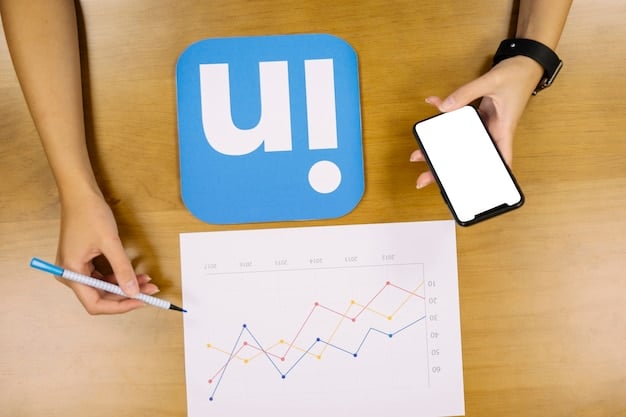Boost Mobile App Engagement: Targeted Push Notifications for US Users

Push notifications, when strategically utilized with targeted messaging, can significantly enhance mobile app engagement among US customers, potentially increasing it by 15% through personalized and timely communication.
Want to boost your mobile app engagement in the US market? Strategic push notifications, combined with targeted messaging, are key to increasing user interaction and driving growth. By delivering personalized and relevant content, you can capture attention and encourage users to return to your app.
Understanding the Power of Push Notifications in US Mobile Commerce
Push notifications have become a cornerstone of mobile app marketing. In the competitive landscape of mobile commerce in the US, understanding how to effectively use them is crucial for driving user engagement and achieving business goals.
This section explores the broad impact that push notifications have on mobile commerce and how can be leveraged for more effective campaigns.
The Rise of Mobile Commerce and User Expectations
Mobile commerce has transformed the way consumers shop and interact with brands. With smartphones in almost every pocket, businesses have a direct line to their customers. However, this also means users are bombarded with information, making it essential to cut through the noise.
To succeed in this crowded space, relevance and value are paramount. Notifications must be timely, personalized, and offer something truly useful to the user.
Why Push Notifications Matter for App Engagement
Push notifications serve as a direct communication channel, allowing businesses to engage users even when they’re not actively using the app. When used strategically, they can:
- Promote special offers and discounts
- Announce new product launches
- Provide order updates and shipping information
- Remind users about upcoming events or appointments
These activities contribute to a 15% increase in the customer engagement.

In conclusion, for an app to succeed in terms of user engagement, it is important to correctly understand, develop and implement push notifications, and deliver relevant and valuable information.
Crafting Targeted Messaging Strategies for US Customers
One-size-fits-all messaging doesn’t work in today’s digital landscape. To truly connect with US customers, you need to tailor your push notifications to their individual needs and preferences.
Targeted messaging is about sending the right message to the right user at the right time, based on their behavior, demographics, and interests.
Segmenting Your Audience for Personalized Notifications
Audience segmentation is the foundation of targeted messaging. By dividing your user base into smaller, more specific groups, you can create notifications that resonate with each segment’s unique characteristics.
Some common segmentation criteria include:
- Demographics (age, gender, location)
- Purchase history
- In-app behavior (e.g., time spent, features used)
- Preferred communication channels
Utilizing Data-Driven Insights to Improve Relevancy
Data is your greatest asset when it comes to crafting targeted messaging. By analyzing user data, you can gain insights into their preferences, behaviors, and needs. Use this information to personalize your notifications and make them more relevant.
Consider factors such as:
- Past purchases
- Browsing history
- App usage patterns
- Location data
This helps you to create a higher value content for the user.
A/B Testing for Optimal Performance
A/B testing is a powerful technique for optimizing your push notification strategy. By testing different elements of your notifications, such as wording, timing, and imagery, you can identify what resonates best with your audience.
Continuously test and refine your messaging to maximize its impact on user engagement.

In conclusion, there is no successful strategy without a correct audience segmentation. A good segmentation, combined with a data analysis can take the push notification strategy to a new level.
Best Practices for Writing Effective Push Notification Copy
The copy of your push notification is what ultimately captures the user’s attention and drives them to take action. Make every word count by following these best practices.
It’s necessary to have a broad view on the best practices when writing push notification copies.
Keep it Concise and Compelling
Push notifications have limited space, so every word must serve a purpose. Get straight to the point and highlight the key benefit for the user. Use strong verbs and compelling language to create a sense of urgency and excitement.
Personalize the Message
Personalization goes beyond simply including the user’s name. Tailor the message to their specific interests and needs. Use data about their past purchases, browsing history, or location to make the notification feel relevant and valuable.
Include a Clear Call to Action
Tell users exactly what you want them to do. Use action-oriented language, such as “Shop Now,” “Learn More,” or “Claim Your Discount.” Make it easy for users to understand the benefit of taking action.
The Importance of Timing and Frequency
Sending too many notifications can annoy users and lead them to disable push notifications altogether. On the other hand, sending too few notifications can result in missed opportunities to engage with your audience.
Timing and frequency is a relevant factor for effectiveness. Sending notifications at the right time, and at a correct frequency is important to user engagement.
Optimizing Send Times for Maximum Impact
The best time to send push notifications depends on your target audience and the nature of your message. Experiment with different send times to see what works best. Consider factors such as:
- Time of day
- Day of week
- User’s location
- User’s past behavior
Setting Frequency Caps to Avoid Annoying Users
Avoid bombarding users with too many notifications. Set frequency caps to limit the number of notifications they receive within a given time period. This helps to maintain a positive user experience and prevent users from disabling push notifications.
- Set a daily or weekly limit on the number of notifications
- Allow users to customize their notification preferences
- Use behavioral triggers to send notifications only when relevant
This enables a more customer centric way of sending push notifications.
Leveraging Rich Media to Enhance Notifications
Rich push notifications include images, videos, and interactive elements. These can significantly enhance the visual appeal of your notifications and drive higher engagement rates.
Users are more likely to notice and interact with visuals. This leads to higher engagement and conversion rates.
Incorporating Images and Videos
Add visually appealing images and videos to your push notifications to capture the user’s attention. Use visuals that are relevant to the message and that showcase the value proposition.
Adding Interactive Elements for Increased Engagement
Interactive push notifications allow users to take actions directly from the notification, without having to open the app. This creates a seamless user experience and can drive higher conversion rates.
- Buttons for quick actions
- Forms for collecting user information
- Carousels for showcasing multiple products
The use of high quality images and videos adds a great value to push notifications.
Measuring and Analyzing Push Notification Performance
Tracking the performance of your push notifications is essential for understanding what works and what doesn’t. By monitoring key metrics, you can identify areas for improvement and optimize your strategy for maximum impact.
Regular analysis can help you to get a more effective strategy.
Key Metrics to Track
Some key metrics to track include:
- Delivery rate
- Open rate
- Click-through rate
- Conversion rate
- Unsubscribe rate
Tools for Tracking and Analytics
There are several tools available for tracking and analyzing push notification performance. These tools can provide valuable insights into user behavior and help you optimize your messaging.
- Firebase
- Amazon SNS
- Braze
| Key Point | Brief Description |
|---|---|
| 🎯 Targeted Messaging | Personalize messages based on user data. |
| ⏰ Optimal Timing | Send notifications at opportune moments. |
| 📊 Data Analysis | Track metrics to refine strategies. |
| 🖼️ Rich Media | Use visuals to enhance engagement. |
FAQ
▼
Push notifications are messages that pop up on mobile devices. App publishers can send them at any time; users don’t have to be in the app or using their devices to receive them. They’re used to drive engagement and provide timely information.
▼
By delivering personalized and relevant content directly to users, push notifications grab attention and encourage users to return to the app. They can share updates, promotions, or reminders tailored to the user’s interests.
▼
Targeted messaging involves sending notifications to specific segments based on their behavior, demographics, and preferences. This ensures that users receive content relevant to them, increasing the efficiency and effectiveness by up to 15%.
▼
Keep the copy concise and compelling. Personalize each message to resonate with the recipient. Always include a clear call to action, indicating the desired response to the notification clearly and directly.
▼
Track metrics like delivery, open, and click-through rates, plus conversions and uninstalls. These metrics offer vital insights, allowing you to refine your push notification strategy for improved engagement and results over time.
Conclusion
Effective push notifications can transform mobile app engagement. By understanding your audience and using targeted messaging strategies, you can create notifications that delight users and drive business results. Don’t underestimate the power of a well-crafted push notification to boost your mobile commerce strategy.





